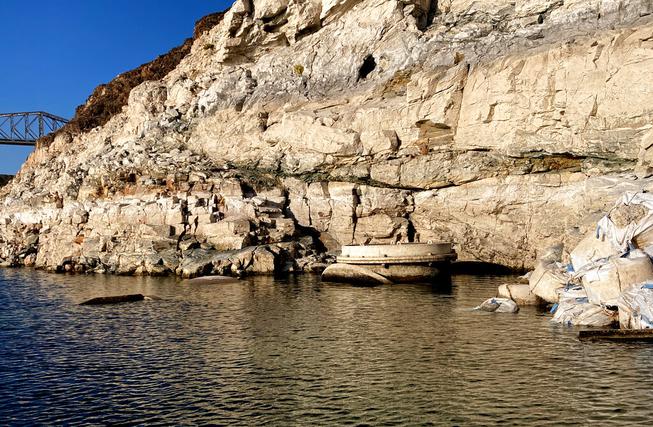
Southern Nevada Water Authority via AP
This photo taken Monday, April 25, 2022, by the Southern Nevada Water Authority shows the top of Lake Mead drinking water Intake No. 1 above the surface level of the Colorado River reservoir behind Hoover Dam.
Sunday, Sept. 4, 2022 | 2 a.m.
View more of the Sun's opinion section
Editor’s note: As he traditionally does around this time every year, Brian Greenspun is turning over his Where I Stand column to others. Today’s guest is Pat Mulroy, former general manager of the Southern Nevada Water Authority, currently president and CEO of Sustainable Strategies and a member of the Wynn Resorts board of directors.
The year was 2002 … it marked the moment when Southern Nevada’s water reality changed forever.
The Colorado River had always experienced years with less-than-normal snowpack, but since the completion of the dam system, it had not experienced 25% of normal runoff. Lake Powell crashed, signaling the onset of a much drier future for a river that everyone had taken for granted.
Southern Nevada’s response was remarkable, transforming itself from the poster child of water waste to the global example of urban water conservation. Unprecedented cooperation emerged among the states and two countries that rely on this resource, and the world watched in awe. Even at that time, we realized that this was more than a drought, and we were experiencing the onset of the consequences of climate change — the speed at which the aridification has occurred was not baked into the forecast.
So here we are just 20 years later and effects that were expected in 2050 or beyond are upon us. And once again the response must be multifaceted … more aggressive conservation, even greater interstate and international cooperation in the short term and a strategic approach to augmentation that looks to stabilize the entire system.
Southern Nevadans, and particularly our business community, are being asked to institute even stricter conservation measures, whether it’s the elimination of future evaporative coolers, restricting pool sizes or reducing golf course water use even further.
We, however, have one major advantage in this area over our neighboring states with Southern Nevada generating “return flow credits” to the Colorado River. This is done by treating and returning all Colorado River water used indoors back to Lake Mead.
So, for example, the fact that the resort industry takes large amounts of municipal water doesn’t have the impact many assume since the vast majority is returned and reused. This is especially true of properties that have old historic groundwater rights that are used for their golf courses, water features and evaporative cooling; in other words, using water that cannot generate a return flow credit because that water didn’t come from the river.
The measures are being viewed by many as severe, but the harsh reality is that if we want our community to enjoy economic prosperity and simply survive, we have no alternative at the moment. Among the states, the near-term solutions are no less painful. At the moment, all we can do is reduce the aggregate use in both the Upper and Lower Basin of the river to at least partially refill Lakes Powell and Mead.
Congress, due to the leadership being shown by our senators, is providing much needed capital to lease water from farmers and fund additional conservation measures to fill the reservoirs and avoid the worst.
It is hard to imagine that next year Lake Mead could actually drop to elevation 1,000 — a mere 100 feet above the point at which no water can go downstream from Hoover Dam. Although Southern Nevada will still be able to access river water because we built the deep intake, California, Arizona and Mexico would receive no water from the Colorado River.
This is neither the time for hyperbole politics nor the blame game; if there was ever a time for statesmanship among the river’s partners it is now. There will be no winners and losers; unless a new level of mutual aid is found, we all lose.
As we struggle through these next difficult years, one point is for certain: Work must begin on a long-term solution that brings stability back to the river. That stability cannot be achieved without augmenting the system by developing a reliable water supply that can supplant some of the river’s current uses.
There must be some carefully developed ocean desalination. I am painfully aware that there isn’t a water project that doesn’t have its opponents but saying “no” to everything is not an option. Those that seek to protect the environment by opposing solutions will find they are destroying the very environment they seek to protect. The question isn’t whether we develop a new supply, but how we do it in a way that also brings environmental relief, protects communities and makes us less vulnerable to climatic vicissitudes. Whatever the project, it must benefit the entire Colorado River community. It will be expensive, but the question isn’t whether we, as a river community, can afford it, but rather whether we can afford to not pursue it.
Despite some dire predictions, I, as always, remain an optimist. I watched our river community come together when it felt like it would never happen. It is not a time to panic, but to act. Once again, the world will observe this amazing community with awe because it has always shown unmatched resilience and the ability to overcome adversity. Each time, it has acted with determination and emerged even stronger. And this challenge will once again prove our ability to adapt and serve as a model for the rest of the world to follow.
